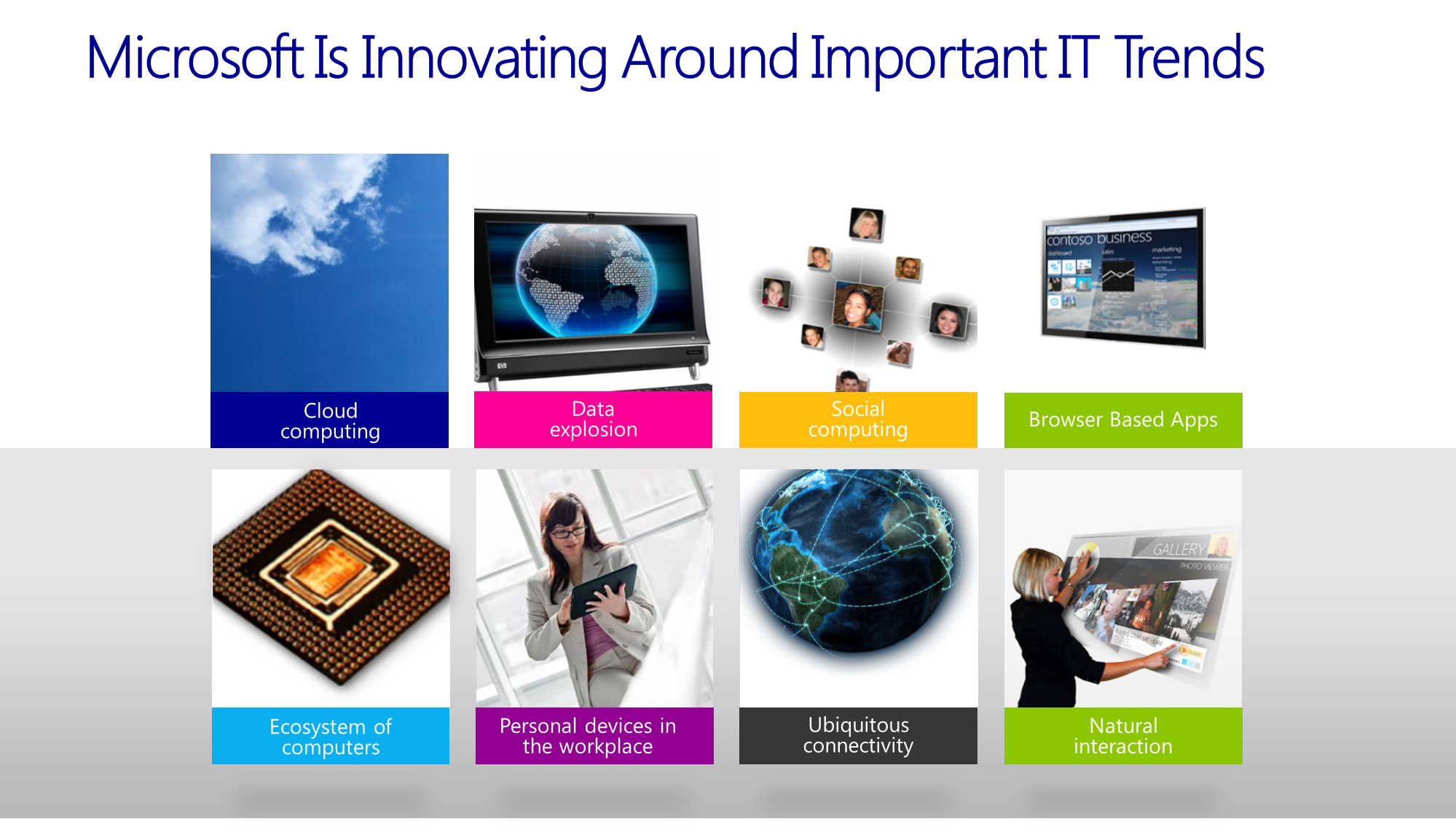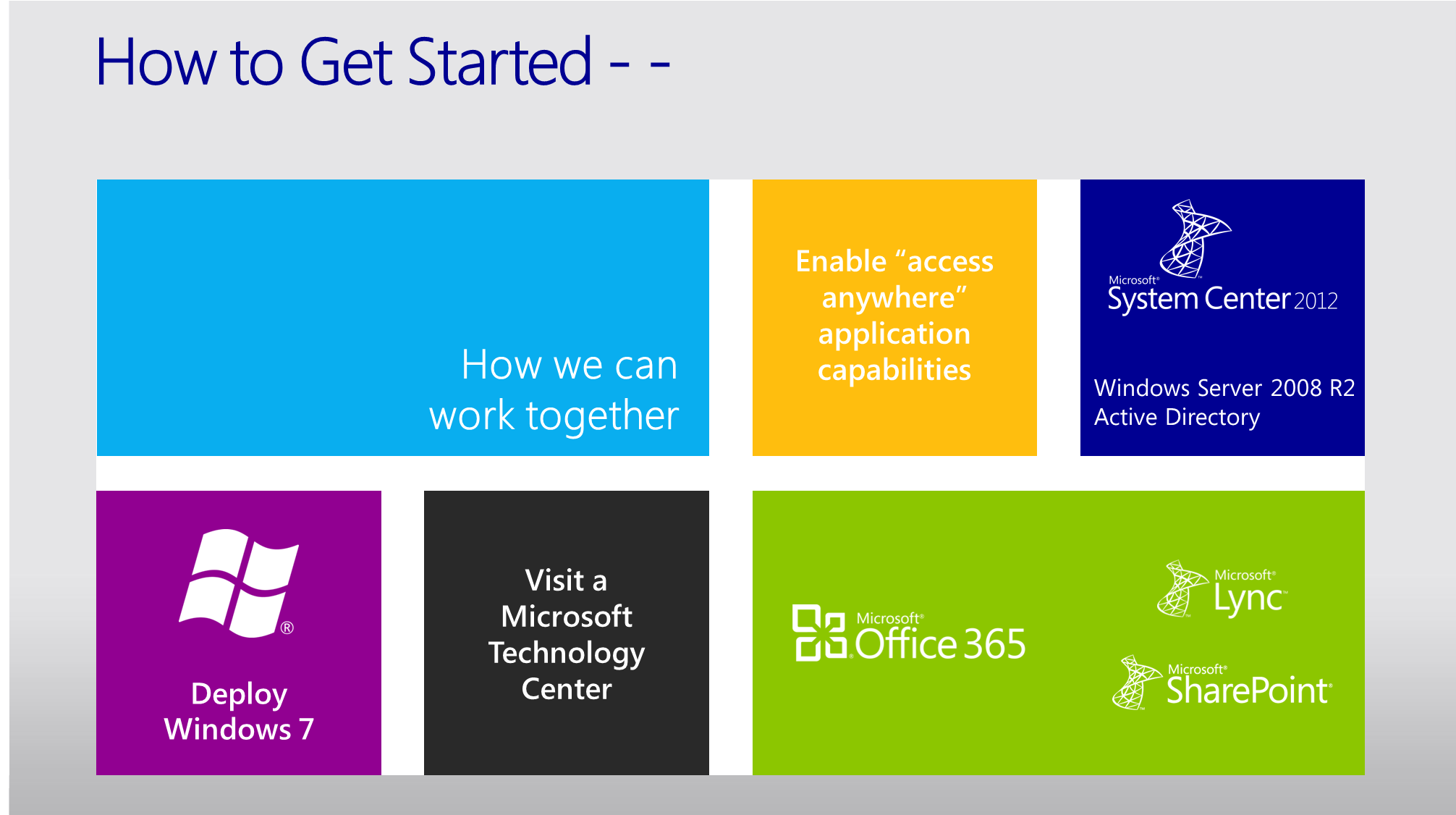Microsoft Embraces the Consumerisation of IT!!
A series of technology trends is leading to rapid progress and change in the technology we use at home, which in turn is influencing how we expect to use technology for work and driving the consumerisation of IT. As these technology trends converge with social and business trends, the role that technology plays throughout our lives will continue to evolve.
-
- The computing ecosystem. Our view of what defines a computer is changing as previously “unintelligent” objects are gaining intelligence, becoming connected, and joining the ecosystem of computing. We are entering the era of an “Internet of things” in which almost any object can be connected to the Internet and collect data that contributes to a global web of knowledge. Virtually every type of product is becoming part of the computing ecosystem—from cars, phones, and houses to scales, cameras, power meters, and televisions. Many of the computers you’ll interact with in the future will be in devices that we don’t think of as computers today. In effect, computing is becoming increasingly invisible. The explosion of data. The
immense number of digital devices in our world is driving an explosion in data. Deep analysis of this vast amount of data is enabling computers to begin to understand the physical world and to behave in a more human way, anticipating our needs and understanding our intentions.
- The computing ecosystem. Our view of what defines a computer is changing as previously “unintelligent” objects are gaining intelligence, becoming connected, and joining the ecosystem of computing. We are entering the era of an “Internet of things” in which almost any object can be connected to the Internet and collect data that contributes to a global web of knowledge. Virtually every type of product is becoming part of the computing ecosystem—from cars, phones, and houses to scales, cameras, power meters, and televisions. Many of the computers you’ll interact with in the future will be in devices that we don’t think of as computers today. In effect, computing is becoming increasingly invisible. The explosion of data. The
-
- Natural interaction. More natural ways to interact with technology are rapidly emerging—multitouch, voice, vision, gestures, and many more. This means that for the first time, computing will adapt to us and demonstrate some degree of “intelligence.” This trend will see computers shift from being tools to being helpers, performing tasks on our behalf based on an awareness of the environments we are in and the context of our actions. Ultimately, this will enable computing interfaces that are far more natural and increasingly simple to use, helping eliminate the learning curve of today’s technology.
-
- Pervasive displays. New display technologies will give rise to displays that are light, portable, flexible and cheap. We’ll carry a screen around with us as easily as we carry a magazine today, and we’ll take for granted the fact that screens are embedded wherever they might be useful—whether we’re at home, at work, on the move, or in public spaces. And ubiquitous connectivity will automatically link our information to those screens when we want to use them.
-
- Social computing. Social computing has already changed how we create and maintain our connections with others. But the world of social computing remains highly fragmented. The lack of integration creates frustrating disconnects that are inevitable when we are forced to switch between services and applications to stay up to date. Social computing will undergo a dramatic transformation as technology advances make it possible to weave our social lives more deeply and more seamlessly into every aspect of our digital lives, so that information from our social networks can provide insights to guide us in the real world and online. Social networking itself will also change, becoming far more visual and less text-centric.
-
- Cloud computing. With its massive data centers, cloud computing delivers virtually infinite resources, providing the storage capacity and processing power to tackle some of the world’s toughest problems in healthcare, the environment, energy, scientific discovery, and many other fields. A hub for all data and information, it will enable us to capture, store, index, parse, and recall as much of our day-to-day lives as we choose to share. It will also provide a platform for orchestrating the flow of information and technology across our lives so that we always have instant access to the tools and information that we need. Fundamental breakthroughs in massively parallel computing will enable us to see patterns in data that can make actionable intelligence more prevalent.
- Ubiquitous connectivity. Increasingly we will be connected at all times to people, information, services and applications without requiring any specific action on our part. This will liberate the information that we have created ourselves and unlock any information from any source that might be relevant to where we are and what we are trying to accomplish, bringing everything we need together seamlessly in the form that is most useful.
Premier Support can help you get started or quicken the pace with which your organisation embraces the changing face of organisational IT services management in the face of the consumerisation of IT.
-Upgrade from Windows XP to Windows 7 today. This is also the best way to start preparing for the next generation of Windows as virtually all applications that run on Windows 7 will run on Windows 8
-Start planning your migrations to System Center 2012 and Active Directory 2008 R2
-Work with us to complete an Optimization/Readiness Assessment of your core infrastructure, your business productivity infrastructure, or your application platform
-Let us help you envision how Microsoft can help with the consumerization of IT with envisioning sessions and architecture design sessions
For more information or to get started, drop us at Premier a line so we can help.

